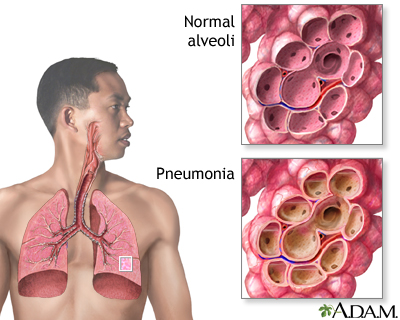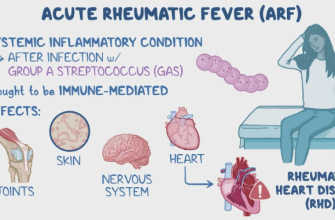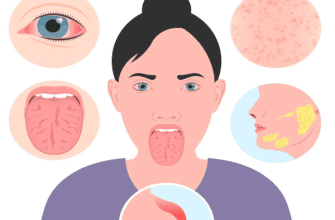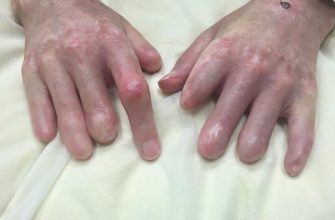What is this?
Pneumonia is a lung condition that causes inflammation, primarily affecting the air sacs in the lungs. It can be caused by various infections, such as bacteria, viruses, fungi, and other microorganisms. Pneumonia can be life-threatening, especially for people with weakened immune systems.
Causes
The most common causes of pneumonia include:
- Bacteria
-Streptococcus pneumoniae – a type of bacteria that is the most common cause of bacterial pneumonia.
-Haemophilus influenzae
-Mycoplasma pneumoniae
-Legionella pneumophila
-Chlamydia pneumoniae - Viruses
-Influenza virus
-Respiratory syncytial virus (RSV).
-The SARS-CoV-2 virus
-Adenovirus
-Rhinovirus. - Fungi:
-Pneumocystis jirovecii (common in immunocompromised individuals, e.g., HIV/AIDS).
-Histoplasma capsulatum.
-Coccidioides immitis. - Other Causes:
-Aspiration of food, liquids, or gastric contents.
-Chemical irritants or toxins.
Types
- Community-acquired pneumonia (CAP)- acquired outside of healthcare settings and most common type.
- Hospital-acquired pneumonia (HAP) -develops 48 hours or more after hospital admission and often caused by drug-resistant bacteria.
- Ventilator-associated pneumonia (VAP) – occurs in people on mechanical ventilation.
- Aspiration pneumonia – caused by inhaling food, liquids, or vomit into the lungs.
- Atypical Pneumonia – caused by bacteria such as Mycoplasma, Chlamydia, or Legionella. Symptoms are often milder but can last longer.
- Opportunistic Pneumonia – occurs in people with weakened immune systems (e.g., HIV patients).
Symptoms
- Common symptoms: Fever, chills, sweating, cough (may produce sputum that can be green, yellow, or bloody), shortness of breath, chest pain (worse with deep breaths or cough), fatigue, loss of appetite.
- Atypical pneumonia symptoms: Milder symptoms like low-grade fever, dry cough, fatigue, headache, muscle pain, sore throat.
- Severe symptoms: Confusion (especially in older adults), cyanosis (bluish skin from lack of oxygen), rapid breathing or heart rate.
Diagnosis
- Clinical evaluation
-History, physical exam - Imaging
-Chest X-ray (the gold standard for diagnosis).
-CT scan (if the X-ray results are inconclusive or there are complications suspected). - Laboratory tests:
-Blood tests (complete blood count, C-reactive protein, blood cultures).
-Sputum culture (to identify the causative organism).
-Arterial blood gas analysis (to assess oxygen levels). - Other tests:
-Pulse oximetry (measures oxygen saturation).
-Bronchoscopy (used in severe or unclear cases).
-Urine antigen tests (Legionella and Streptococcus pneumoniae).
Treatment:
- Antibiotics:
-For bacterial pneumonia, antibiotics such as amoxicillin, azithromycin, and ceftriaxone are commonly used.
-The choice of antibiotic depends on the suspected pathogen and local resistance patterns. - Antiviral medications:
-Oseltamivir is used for influenza. - Antifungal medications:
-Fluconazole and trimethoprim-sulfamethoxazole are used for fungal pneumonia, such as Pneumocystis. - Supportive care:
-Oxygen therapy for low oxygen levels.
-Intravenous fluids for dehydration.
-Pain relievers, such as acetaminophen and ibuprofen, can help with fever and pain.
Hospitalization may be required for severe cases, particularly in high-risk patients.
Complications
- Respiratory Failure: Severe pneumonia can impair oxygen exchange.
- Sepsis: An infection that spreads to the bloodstream.
- Lung abscess: Formation of pus in the lung.
- Pleural effusion or empyema: Accumulation of fluid or pus around the lungs.
- Acute respiratory distress syndrome (ARDS): Severe inflammation and fluid leakage in the lungs.
Prevention
- Vaccination: Pneumococcal vaccines (PCV13, PPSV23) for high-risk individuals and annual influenza vaccine, COVID-19 vaccine.
- Hygiene: Regular handwashing, covering mouth and nose when coughing or sneezing.
- Lifestyle modifications: Avoiding smoking, maintaining a healthy diet, and exercising regularly.
- Prophylaxis: Taking preventive measures to reduce the risk of infection.
Antibiotics or antifungal medications for immunocompromised individuals, such as those with HIV, may be necessary to prevent pneumonia.







